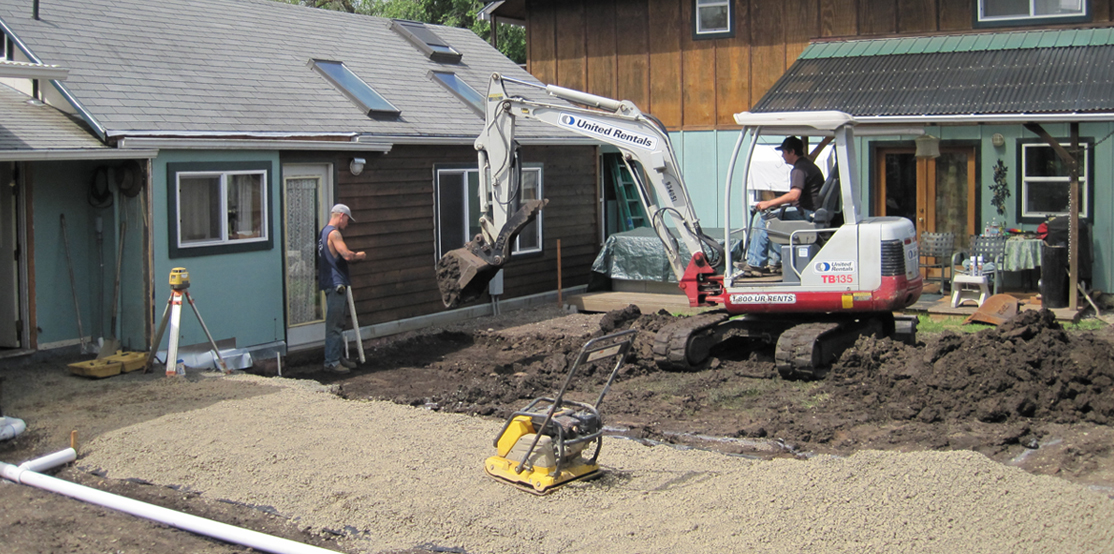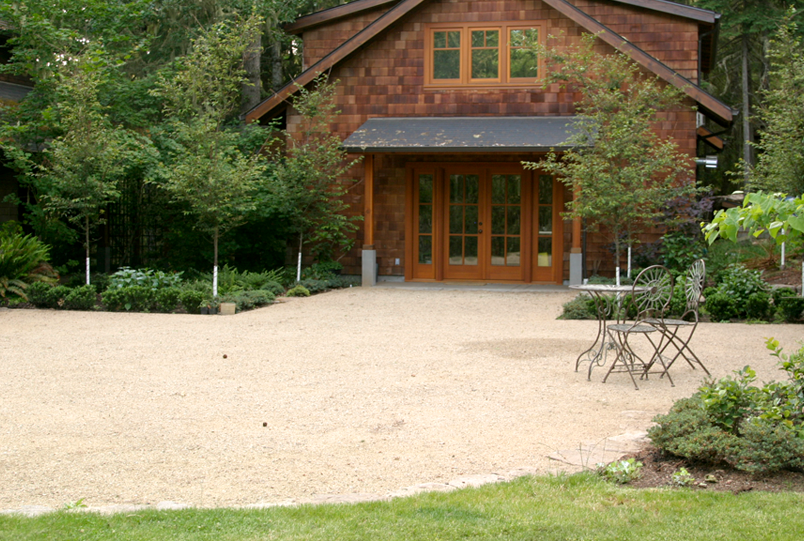
Now that the rainy days in Eugene outnumber the sunny, have you noticed wet patches and mud pits growing in your landscape? Ask yourself - do these mucky areas reappear every winter and keep you out of your garden all season long? An emergent sea of mud is more than an annoyance. Improper drainage results in unusable outdoor spaces. Bog-like conditions in areas of circulation such as walkways or paths can be dangerous – not to mention horribly messy as you move between the indoors and the out.
Perhaps when summer arrives and the water retreats, you forget about this reoccurring rainy season problem. But now that the wet has settled in for the foreseeable future, let’s take care of it once and for all.
Grading and drainage is a delicate art and best tackled by landscape architects. These rainy days provide opportunities for us to observe your landscape and identify the tell-tale signs of dysfunctional drainage. It is easy to see where water pools, but it is more difficult to understand why. We will brainstorm strategies to address drainage problems including soil amendment, sub-grade infrastructure, surface drains, and most importantly, grade manipulation. In many of our past projects, such as the Wiley Garden, we were able to design solutions that transformed constantly wet and uninviting outdoor areas into landscape rooms that you can actually live in all year long.

In Eugene the rain lasts for a long time, but Oregonians don't let rain derail productivity and forward progress. The winter is the ideal time to initiate the design process for your landscape. The rainy months allow the right amount of time for dreaming and scheming. We have found that the most successful designs begin with a clear vision of what it is that you want. Do you envision a garden bursting with color and vibrancy or do you dream of a tranquil retreat? A good way to get the creative juices flowing is to look for inspiration on sites like Houzz or Pinterest, in magazines like Landscape Architecture Magazine or Sunset, and in books. Think of adjectives that best describe the images that you are drawn to, and create groupings of words that summarize your style. Are you going for elegant, simple, and contemporary? How about lush, boisterous, and playful? Identify key words like “edible landscapes” or “sustainable design” that tend to pop up repeatedly in your search. The combination of visual imagery and written description adds to the refinement of your ideas and helps to clarify design intent.
During this phase of gathering inspiration, also think about how you want to live in your landscape. Are you passionate about entertaining and crave an outdoor dining area with easy access to the kitchen? Do you daydream about summer naps in a shady hammock? Are you looking for a way to incorporate chickens into the garden? Think about how much time you want to spend maintaining your landscape. Do you want to spend a day working your garden only once or twice a season, or do you enjoy doting over tender plantings on a regular basis? If you spend the time to contemplate these questions, we will be able to help you match your design goals with your lifestyle.
Once you initiate a working relationship with Lovinger Robertson Landscape Architects, we will sit down with you to talk about your landscape, your ideas, and your needs and wants. Then we can start to contribute our expertise in order to help you accomplish your vision.

What is the place of cars in the garden? First let’s ask ourselves if feelings we associate with cars and driving are compatible with the home environment we want to cultivate. Instead of going straight from our car to our front door, wouldn’t we rather cultivate an intentional entry that prepares us to find the refuge of home?
The journey to refuge can begin even before we exit our cars. After driving on miles of asphalt, a new surface material tells us to start slowing down (literally and metaphorically). It is a signal that we are home. The sound of tires crunching over gravel or dully thudding over cobblestones further reinforces the sense of welcome while also alerting waiting loved ones that we have arrived.
Then there’s the challenge of elegantly folding parking into the sequence of garden spaces. Do we want to dominate a space for the exclusive use of parking? Or is there a way to overlap uses to get the most out of our landscape? How might a parking courtyard accommodate cars as well as human comfort? The relaxing sound of a water feature could encourage us to leave the hassle of the day behind. An integrated seating area could give us just another few minutes to unwind and sort the mail before stepping inside. Or perhaps after a long day, we just want a welcoming space to take a moment to watch the play of light as the sun goes down.
In some contexts, we may want to leave our cars even farther behind and out of sight. In order to take in the full splendor of our landscape, we don’t want to see any icons of the business of everyday life. Constantly catching a glimpse of our cars reminds us of work to be done, errands to be run, meetings to make…. Parking remotely gives us the opportunity to create a protracted, choreographed entry to our private places of retreat. This choreography of transition is unique to each home and landscape, responding to inherent characteristics and highlighting distinctive qualities.